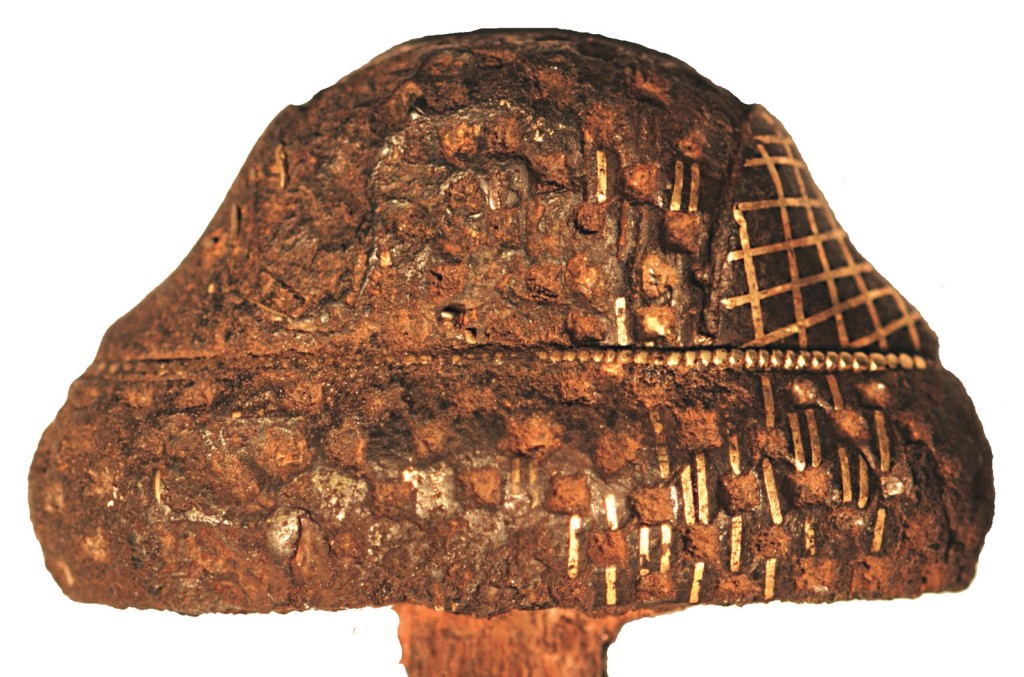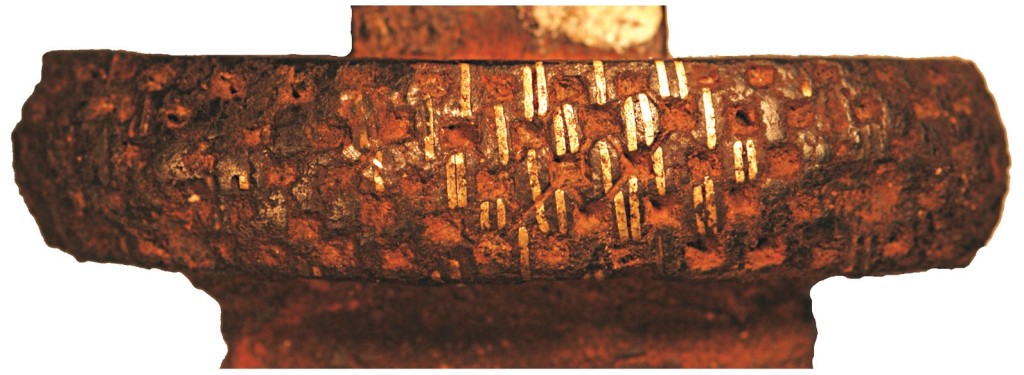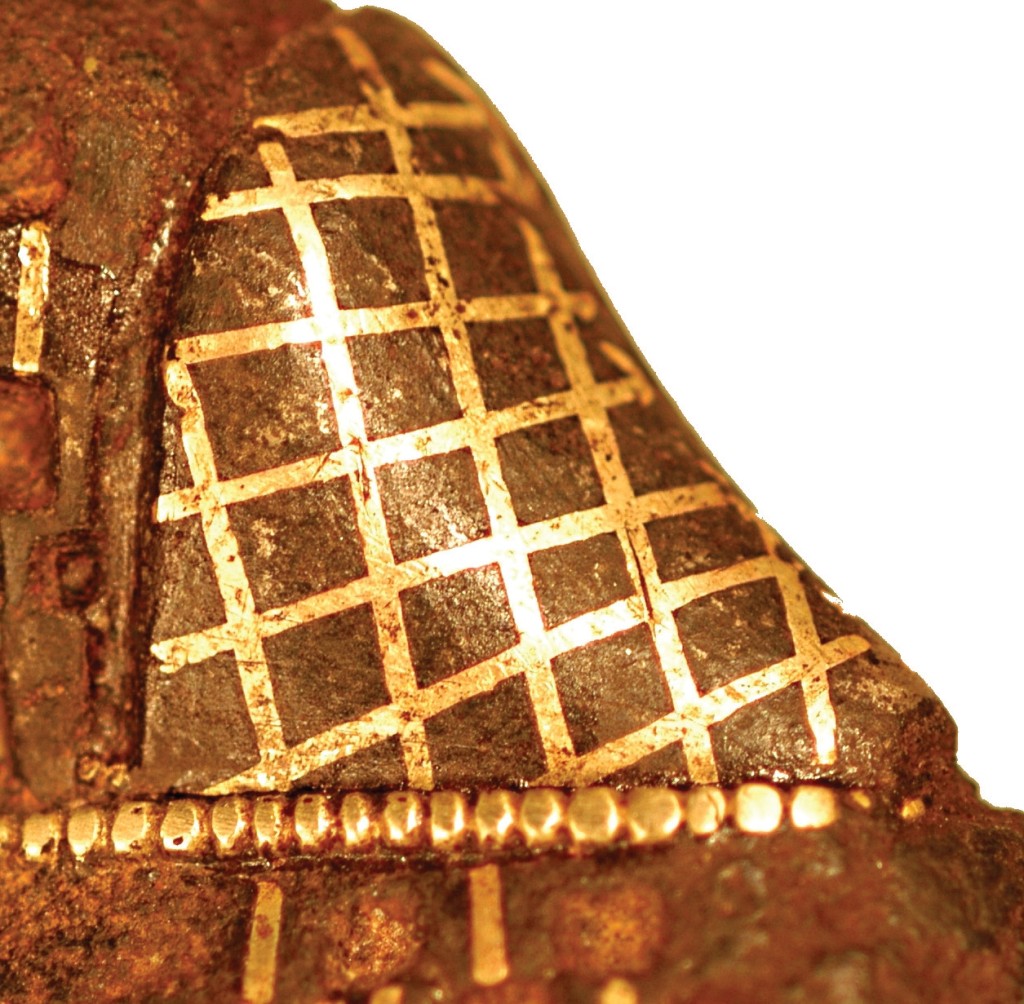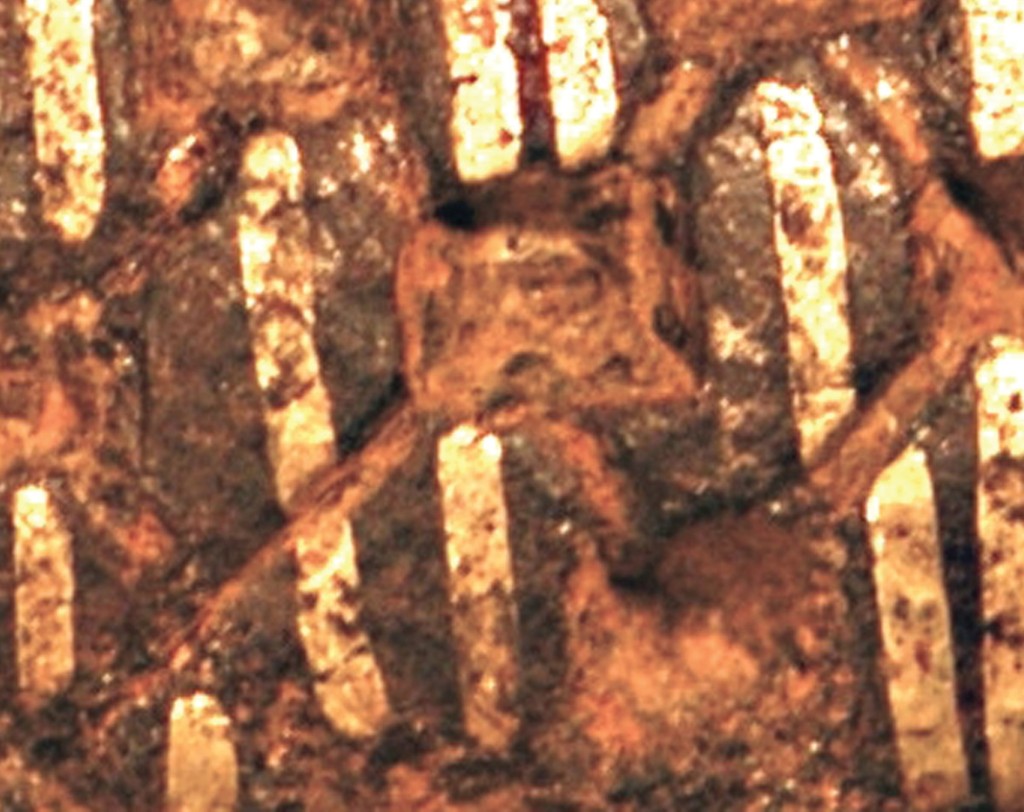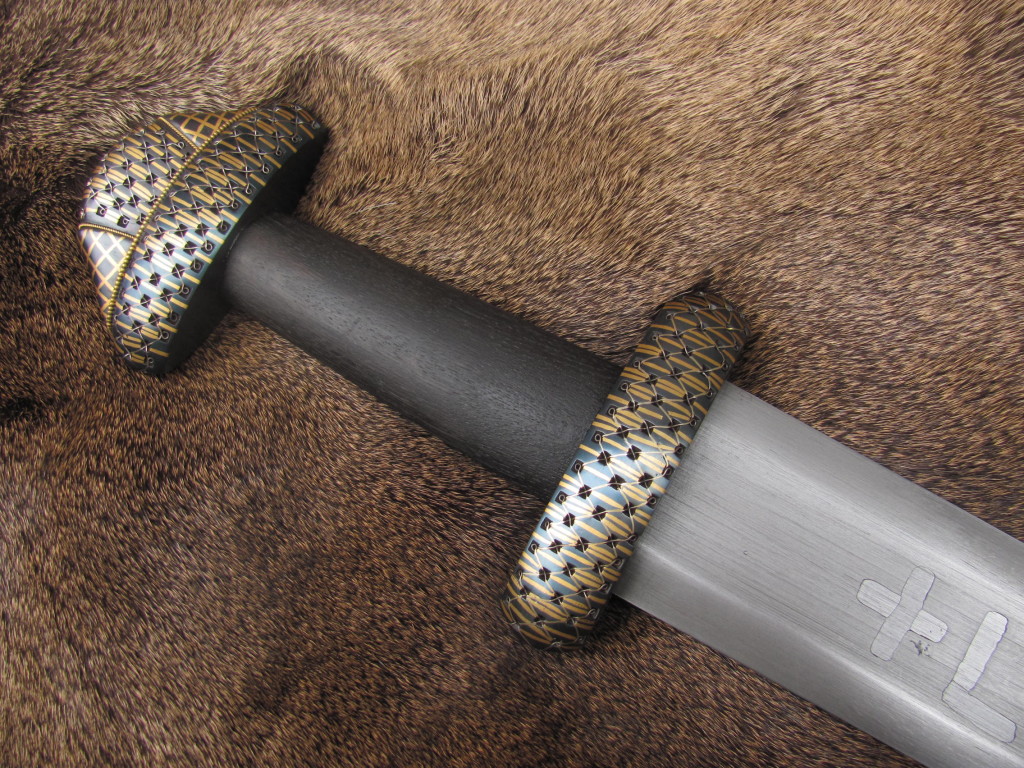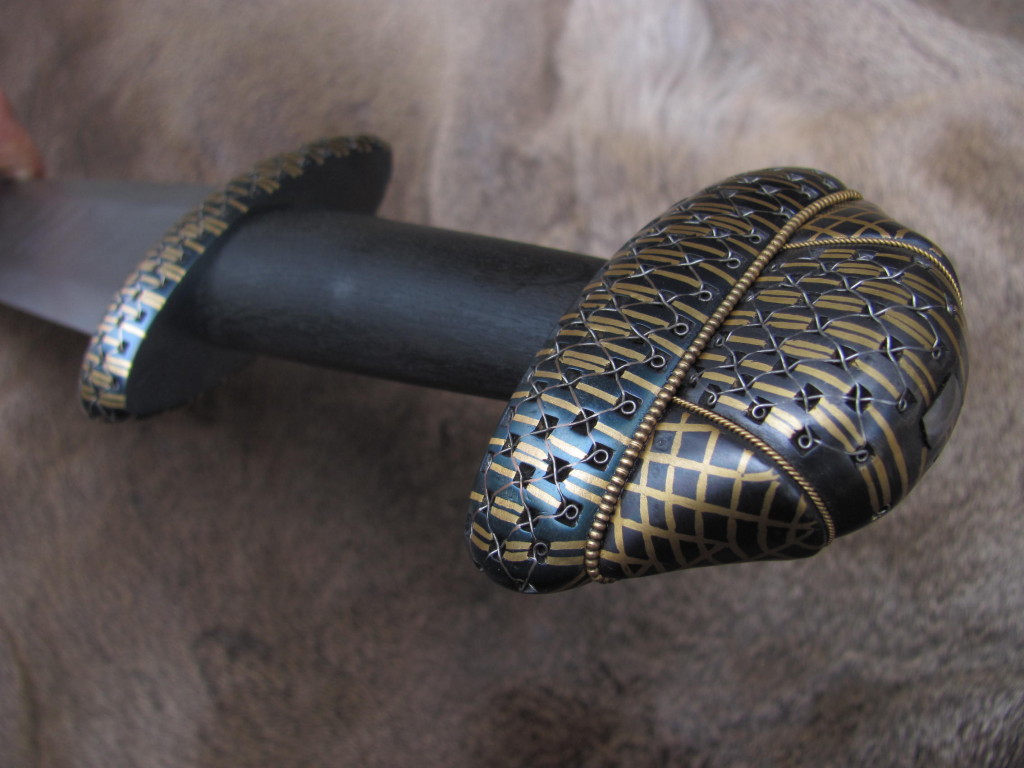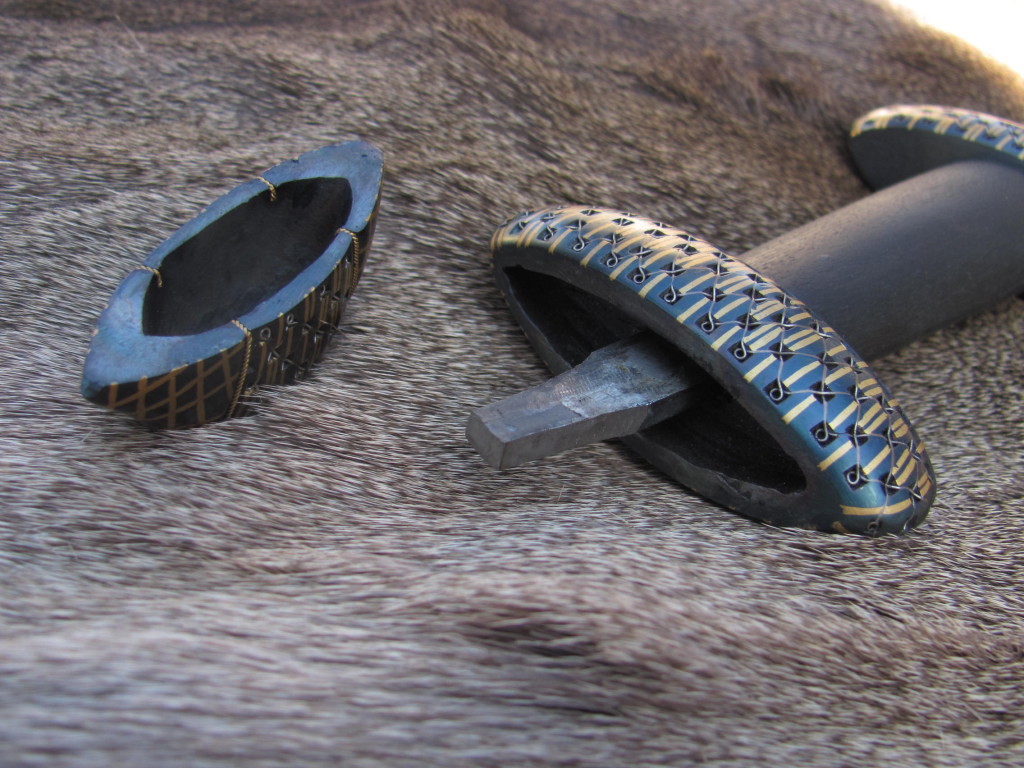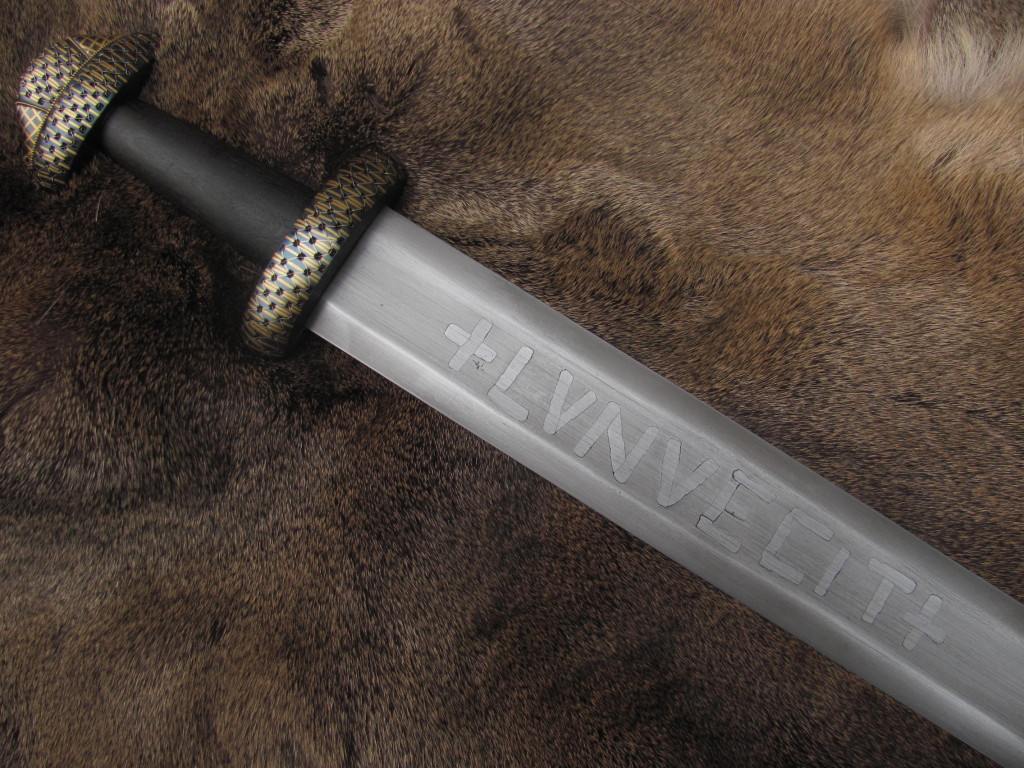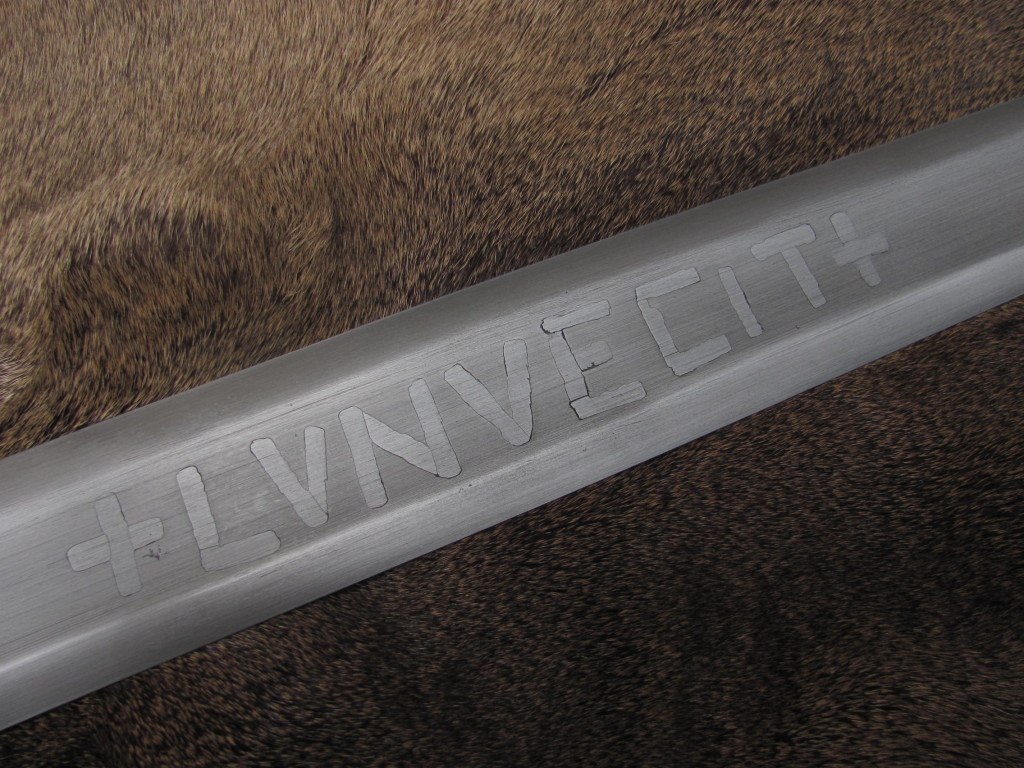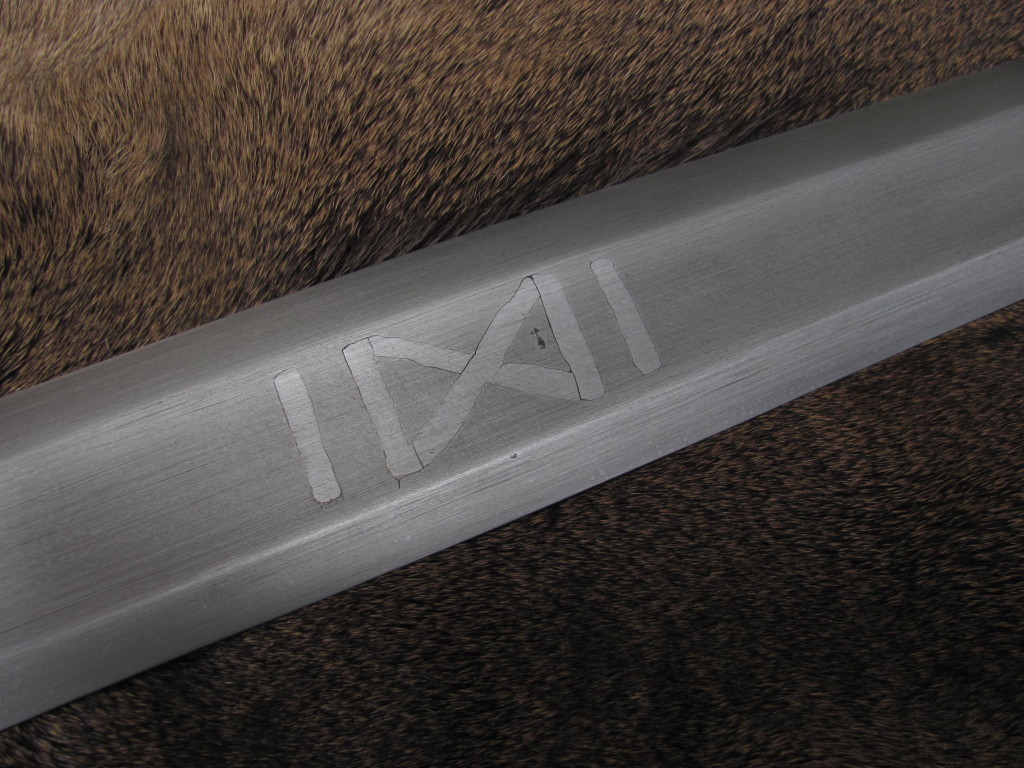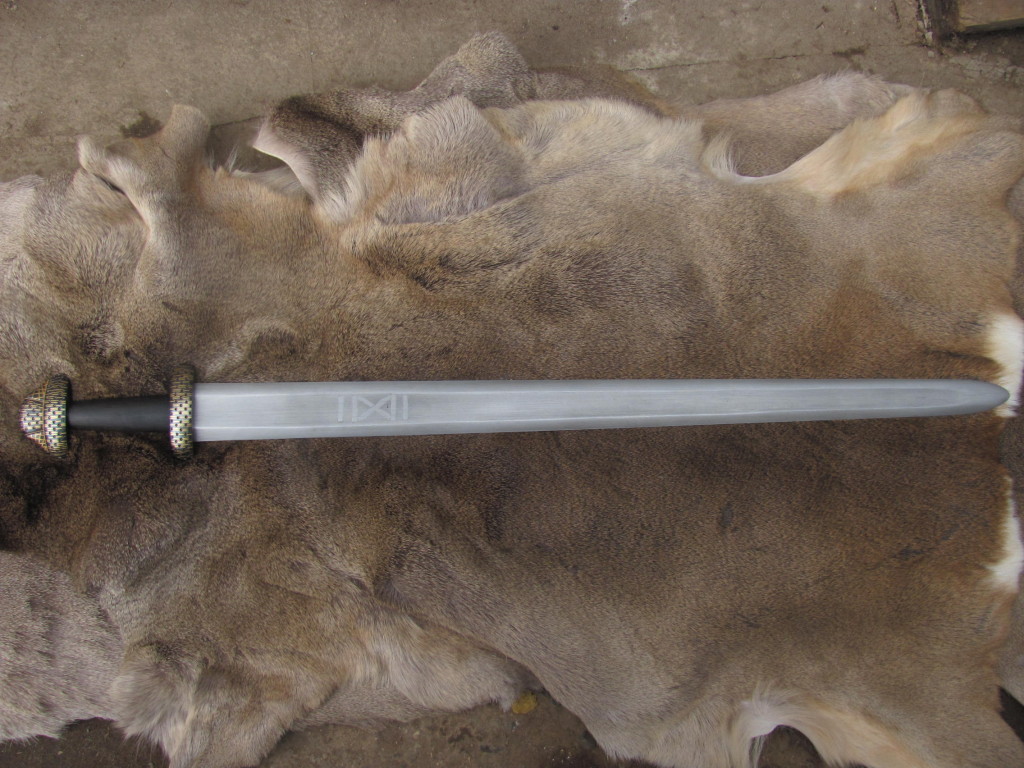ANALYSIS

Sarskoe Gorodishche (Hillfort on the bank of the Sara River) is one of the few settlements on the territory of ancient Russia, where a large amount of Scandinavian material culture occured. Both quality and quantity bears witness of not only trade contacts, but also of direct Scandinavian presence on the site. The most representative collection of Scandinavian objects is weaponry, mainly arrow tips, sword and seax chapes and a sword. The sword will be the topic of this article.
According to some sources, the sword was discovered on the slope of Sarskoe Gorodishche by D. N. Eding and D. A. Ushakov in 1930. However, the sword was firstly published A. N. Kirpichnikov in 1966, as a find from a mound (Kirpichnikov 1966: 80, No. 49). The sword was studied several times (Kirpichnikov 1992: 79, Leontiev 1996: 121; Kainov 2000: 252-256); nevetherless, in 2003, the sword was studied again and some new decoration was discovered. At the present time, the weapon is deposited in Architecture and Art Museum in Rostov (Ростовское архитектурно-художественное музей; catalogue number Р 10335, А- 92).
The lenght of the sword is 94.6 cm, the blade is 78.4 cm long. The blade has the width of 55 mm by the crossguard and 30 mm by the tip (30 mm far from the tip, respectively). The thickness of the blade by the crossguard is 5 mm. The fuller is 23 mm wide and 1 mm deep in the upper part of the blade. The crossguard (lower guard) is 90 mm wide and 20 mm high, while the upper guard (base of the pommel) is 80 mm wide and 20 mm high. The pommel has the height of 46 mm.


Both hilt and blade are very well preserved. The shape of the hilt belongs to the Petersen type E, which was very popular type with at least 130 examples in whole Europe (39 from Sweden, 38 from Norway, 20 from Finland, 15 from the Ancient Rus, 6 from Estonia, 6 from the former Prussia, 4 from Ireland, 1 from Poland and 1 from Denmark; Kainov 2012: 19-21 and my personal observations). More correctly, the shape of the hilt should be classified as the subtype E3. This subtype is “represented by hilts decorated with oval pits arranged in trefoil or quatrefoil compositions” (Androshchuk 2014: 53; Kainov 2001: 57). To compare, Androshchuk lists at least 5 Swedish swords of the subtype E3 (ibid.). Until 2003, all studies had been pointing out that the sword from Sarskoe Gorodishche had been a typical example of this subtype, but after the examination, the sword showed to be rather unique. The reason is its decoration, which is not typical for any subtype of the type E. The decoration is why we should thing the sword forms “a separate variant of the E-type swords” (Kainov 2011: 149).

In 2003, a diagonal grid of inlayed yellow metal wire was discovered on both sides of the pommel. The wire is about 1 mm thick. Such a decoration is very rare and the closest analogies – two swords from Gotland (SHM 16905, GF C 4778) – belong to the Mannheim sword type (special type 2), with not less than 20 examples dating from the second half of the 8th century to the beginning of the 9th century (Kainov 2011: 148).
What is more, the examination discovered the fact that pits situated on the central part of the pommel, upper and lower guards are not oval nor round, but square. To my knowledge, no other sword shows this type of pit decoration. These pits are arranged in a checkerboard pattern, sometimes quite uneven. Corners of pits are connected with grooves, which were probably empty and were punched after applying inlayed stripes from yellow metal. Inlayed stripes always occur in paires or threesomes between pits; they are uneven, with spaces ranging from 0.2 to 1.5 mm.
The upper guard and the pommel were separated with a helix from twisted wires of yellow metal. By the same method, the central part of the pommel was separated from side parts. The helix is stamped in order to form pearl-like balls (so called beaded wire). This method is rare on Viking Age swords, with only several known examples from Norway (C8598 – type E, B6685a – type H), Sweden (SHM 34000:942 – special type, SHM 34000:850 – type H/I), Denmark (C3118 – special type 1), Ireland (WK-5 – type K, WK-33 – type D) or France (JPO 2249 – type H). Ends of wire helix is hidden under the pommel.
Details of the hilt of the sword. Taken from Kainov 2011: Fig. 2-9.

The blade belongs to the Geibig’s type 3, which is dated to period between 750 and 975 AD and is characterised by gently tapering blade with tapering fuller, blade lenght between 74 and 85 cm and blade width between 5.2 and 5.7 cm (Geibig 1991: 86, 154; Jones 2002: 22-23). On one side of the blade, there is an unique Latin inscription +LVNVECIT+, on the other side can be found the sign IᛞI (horizontally situated hourglass with two vertical bars before and after). These inscriptions are made by welding of simple iron rod on the surface. The method of welded inscriptions can be attested on dozens of European swords; the raw material varied from iron and steel rods to pattern welded material (see Moilanen 2006).
The most common welded Latin names on blades are Vlfberht, Ingelrii and Hiltipreht, while the less known are Abbo, Atalbald, Banto, Benno, (C)erolt, Gecelin, Hartolfr, Inno, (L)eofri(c), Leutlrit, Niso, Pulfbrii or Ulen. These names probably denote makers or workshops, since some names have the addition (me)fecit, “made (me)”. Among others, magical formulas occur sometimes (their shortcuts respectively), like SOOSO (“S[ALVATOR] O[MNIPOTENS] O[MNIPOTENS] S[ALVATOR] O[MNIPOTENS]) or INIOINI (I[N] N[OMINE] I[ESU] O[MNIPOTENS] …). As the result, the inscription +LVNVECIT+ (“Lun made”) denote the unknown maker Lun and the sign IᛞI is probably the shortcut for the formula In nomine Iesu (“In the name of Jesus”).

Regarding the dating of the sword, it is very complicated to date an untypical object like this one. Besides some exceptions, Scandinavian swords of the type E are dated to the 9th century, while Russian examples are dated to the 10th century (Kainov 2011: 149). So, the shape of the hilt can be dated to the 9th or 10th century. The diagonal inlayed grid on the sides of the pommel has analogies in the 8th and 9th century. The beaded wire was used in the same period, in the 8th and 9th century. The shape of the blade can be dated to the period between 750 and 975 AD. Mentioned Latin names were used from the 9th to 11th century. It seems logic to think that the sword from Sarskoe Gorodishche belongs to the transitional type between the Mannheim type (special type 2) and the type E (Kainov 2011: 149). The sword, or at least the blade, was probably made in the 9th century on the Continent and used until the 10th century by a man with strong connections with Scandinavia.

REPRODUCTION
The sword from Sarskoe Gorodishche has been recently (winter 2015 – spring 2016) replicated by famous Belorussian swordmaker, skillful crafter and my friend Dmitry Khramtsov (aka Truin Stenja). Even though I think the sword is the best copy of the found, I hold the opinion that the Dmitry’s version needs a short comment.

Regarding the sizes, the sword is true copy. The weight of the sword is 1370 grams, an average weight for a type E sword. The inscription was correctly done from iron rods. The handle was made from bog oak, which seems to be a good choice, as no traces of the organic handle survived. The upper guard and the pommel are hollowed, which is characteristic for the type E. Inlayed motives on the hilt (stripes and the diagonal grid) are made from copper alloy wire in the right manner. What is striking on this copy is the usage of silver wire grid in pits and grooves. This decoration is not known from any sword find and it seems like misunderstanding of a rare method used on several swords of types E and T from Sweden (Gräfsta [SHM 19464:6]; Birka grave 524 [SHM 34000:524]), Russia (Gnezdovo mound L-13; Ust-Ribezgno mound XIX and a sword deposited in Kazan museum) and Ukraine (Gulbishche) (see Androshchuk 2014: 53; Arendt 1936; Kainov 2012: 19-25). The method is described by Arendt (1936: 314):
“Both guard and the pommel form a kind of containers or coverings, which contain smaller but equally shaped parts. These latter [inner parts] were braided with silver wires and placed in the way that their crossings were just under the pits in containers.”
It seems that Dmitry based his version on some pictures of destroyed hilts, where the wire jutted out through damaged pits to the surface. However, I still think that Dmitry’s copy is the best version of the sword ever made and that Dmitry took the chance to fill rather illogical (and pattern destroying) grooves with more decoration. We should understand the version as a combination of outstanding replica and a free interpretation of the author.
If you wish to write to the author, please, use this email adress:
truin.dimastai@mail.ru
ACKNOWLEDGEMENT
This article would never existed without the spectacular work of Dmitry Khramtsov, who inspired me and kindly send me photos in original resolution. All my thanks and respect also go to Sergey Kainov, who helped me with his best advices and answered all my bothering questions.
I hope you liked reading this article. If you have any question or remark, please contact me or leave a comment below. If you want to learn more and support my work, please, fund my project on Patreon or Paypal.
BIBLIOGRAPHY
Androshchuk 2014 = Androshchuk, F. (2014). Viking swords : swords and social aspects of weaponry in Viking Age societies. Stockholm.
Arendt 1936 = Arendt, W. W. (1936). Ett svärdsfäste från vikingatiden. In: Fornvännen 31, pp. 313-315. Online.
Geibig 1991 = Geibig, A. (1991). Beiträge zur morphologischen Entwicklung des Schwertes im Mittelalter : eine Analyse des Fundmaterials vom ausgehenden 8. bis zum 12. Jahrhundert aus Sammlungen der Bundesrepublik Deutschland. Neumünster.
Jones 2002 = Jones, L. A. (2002). Overview of Hilt and Blade Classifications. In. Oakeshott E. – Peirce I. G. Swords of the Viking Age, pp. 15-24.
Kainov 2000 = Kainov, S. Yu. (2000). Меч с Сарского городища. / Сообщения Ростовского музея. Вып.Х. pp. 252-256. Online.
Kainov 2001 = Kainov, S. Yu. (2001). Еще раз о датировке гнёздовского кургана с мечом из раскопок М.Ф.Кусцинского (К вопросу о нижней дате Гнёздовского могильника) // Гнёздово. 125 лет исследования памятника. Труды Государственного Исторического музея. Вып. 124, pp. 54-63. Online.
Kainov 2011 = Kainov, S. Yu. (2011). Новые данные о мече с Сарского городища // Военная археология. Вып.2. Сборник материалов Проблемного Совета “Военная археология” при Государственном Историческом музее, pp. 147-152. Online.
Kainov 2012 = Kainov, S. Yu. (2012). Swords from Gnёzdovo. In: Acta Militaria Mediaevalia VIII, pp. 7-68. Online.
Kirpichnikov 1966 = Kirpichnikov, A. N. (1966). Древнерусское оружие: Вып. 1. Мечи и сабли IX– XIII вв.// АН СССР, Москва.
Kirpichnikov 1992 = Kirpichnikov, A. N. (1992). Новообнаруженные клейма раннесредневековых мечей // Fasciculi Archaeologiae Historicae. Fasc. V, pp. 61-81.
Leontiev 1996 = Leontiev А. Е. (1996). Археология мери. К предыстории Северо-Восточной Руси // Археология эпохи великого переселения народов и раннего средневековья. Выпуск 4, Москва.
Moilanen 2009 = Moilanen, M. (2009). On the manufacture of iron inlays on sword blades: an experimental study. In: Fennoscandia archaeologica XXVI: pp. 23-38. Online.
Petersen 1919 = Petersen, J. (1919). De Norske Vikingesverd: En Typologisk-Kronologisk Studie Over Vikingetidens Vaaben. Kristiania.
